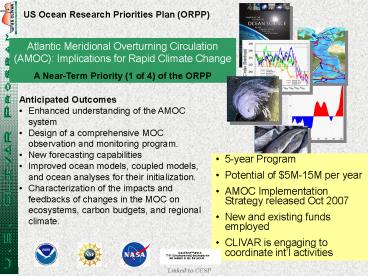Linked to CCSP - PowerPoint PPT Presentation
1 / 9
Title:
Linked to CCSP
Description:
Atlantic Meridional Overturning Circulation (AMOC): Implications for ... Enhanced understanding ... Josh Willis, NASA-JPL. Tony Lee, NASA-JPL. Jim Carton, ... – PowerPoint PPT presentation
Number of Views:50
Avg rating:3.0/5.0
Title: Linked to CCSP
1
US Ocean Research Priorities Plan (ORPP)
Atlantic Meridional Overturning Circulation
(AMOC) Implications for Rapid Climate Change A
Near-Term Priority (1 of 4) of the ORPP
- Anticipated Outcomes
- Enhanced understanding of the AMOC system
- Design of a comprehensive MOC observation and
monitoring program. - New forecasting capabilities
- Improved ocean models, coupled models, and ocean
analyses for their initialization. - Characterization of the impacts and feedbacks of
changes in the MOC on ecosystems, carbon budgets,
and regional climate.
- 5-year Program
- Potential of 5M-15M per year
- AMOC Implementation Strategy released Oct 2007
- New and existing funds employed
- CLIVAR is engaging to coordinate intl activities
Linked to CCSP
2
AMOC Programmatic Development
- January 2007 NSTC/JSOST Ocean Research
Priorities Plan (ORPP) released. Identifies
Atlantic MOC (AMOC) as one of four near-term (5
year) priorities. 5M-15M per year in support. - May 2007 AMOC Planning Team formed
- October 2007 AMOC Implementation Strategy
published - Feb 2008 AMOC Science Team (AMOCST) formed
- March 2008 AMOCST first meeting
- FUNDING FY08 Up to 5M in new funding, some
activities supported through existing funds - FY09 Additional funds requested by the
President long way to go
3
AMOC Implementation Strategy (Oct 2007)
AMOC Motivating Questions
- What is the current state of the AMOC?
- How has the AMOC varied in the past on
interannual to centennial time scales? - What governs AMOC changes?
- Is the AMOC predictable on 10-100 year
timescales? - What are the impacts of AMOC variability and
change?
AMOC Scientific Objectives
- The design and implementation of an AMOC
monitoring system - An assessment of AMOCs role in the global
climate - An assessment of AMOC predictability
4
AMOC Implementation Strategy (Oct 2007)
Specific Expected Outcomes
- The identification of an AMOC "fingerprint" and
indices based on observable variables and
paleo-proxies (2011-2012) - An estimate of the current state and variability
of the AMOC (2008-2011) - The design and initial implementation of a
trans-basin AMOC monitoring network (2008-2012) - An assessment of AMOC meridional connectivity and
property (e.g. mass, heat, freshwater) transports
(2008-2011) - The identification of mechanisms important for
AMOC variability and assessment of AMOC
predictability (2008-2012) - An updated assessment of the risk of rapid change
in AMOC affecting our climate (2010-2012) - The characterization of the role in climate
system and potential impacts (e.g., on the
climate system, ocean variables, sea level, etc.)
of AMOC changes (2009-2012)
5
AMOC Program Execution
AMOC Science Team Chair Susan Lozier
U.S. CLIVAR Inter-Agency Working Group
(David Legler - US CLIVAR Office)
NOAA Climate Program Office (CPO) Observing
systems, monitoring, climate modeling James Todd,
Climate Variability and Predictability
Program Mike Johnson, Climate Observations
NSF Geosciences program Process studies, models,
and observations Eric Itsweire, Physical
Oceanography Program Walter Robinson, Climate
Dynamics
NASA Earth Science Division Satellite data
analyses, modeling and space-based
observations Eric Lindstrom, Physical
Oceanography Program, AMOC Lead
6
AMOC Summary
- US AMOC effort underwayscope and size will be
determined by availability of resources. Some - Great interest/need to coordinate with
international AMOC activities (Atlantic Panel) - AMOC activities and CLIVAR/GSOP
- Contribution to Oceanobs 09?
- Increase in support for ocean data assimilation
particularly aimed at AMOC issues - Increased focus on decadal variability/predictabil
ity studies, especially initialized climate
predictions
7
(No Transcript)
8
AMOC Science Team (Mar 2008)
- Susan Lozier, Duke University
- John Toole, WHOI
- Ping Chang, TAMU
- Bill Johns, RSMAS-Univ of Miami
- Molly Baringer, NOAA-AOML
- Tom Delworth, NOAA-GFDL
- Tim Liu, NASA-JPL
- Sirpa Hakkinen, NASA-GSFC
- Josh Willis, NASA-JPL
- Tony Lee, NASA-JPL
- Jim Carton, University of Maryland
AMOCST will expand with funding of additional
FY08 proposals
9
AMOC Implementation Strategy (Oct 2007)
Recommended Activities
- Develop an AMOC state estimate or fingerprint
- Monitor AMOC transports
- Evaluate coherence and connectivity of AMOC
circulation and transports - Assess AMOC observing systems with ocean models
- Reconstruct AMOC variability and associated
property fields - Model the ocean state during the instrumental
period - Develop longer-term proxies for AMOC variability
- Diagnose mechanisms of AMOC variability and
change - Assess AMOC predictability
- Determine impact and feedback of AMOC variability
- Assess role of AMOC in producing observed changes































